Exploring the Worth and Features of a 0.5 ct Diamond
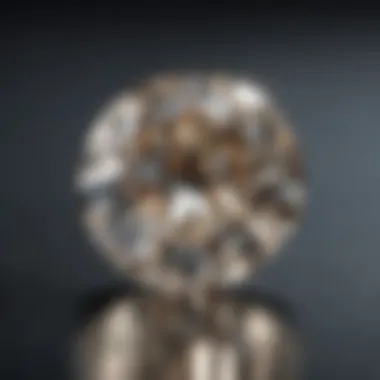
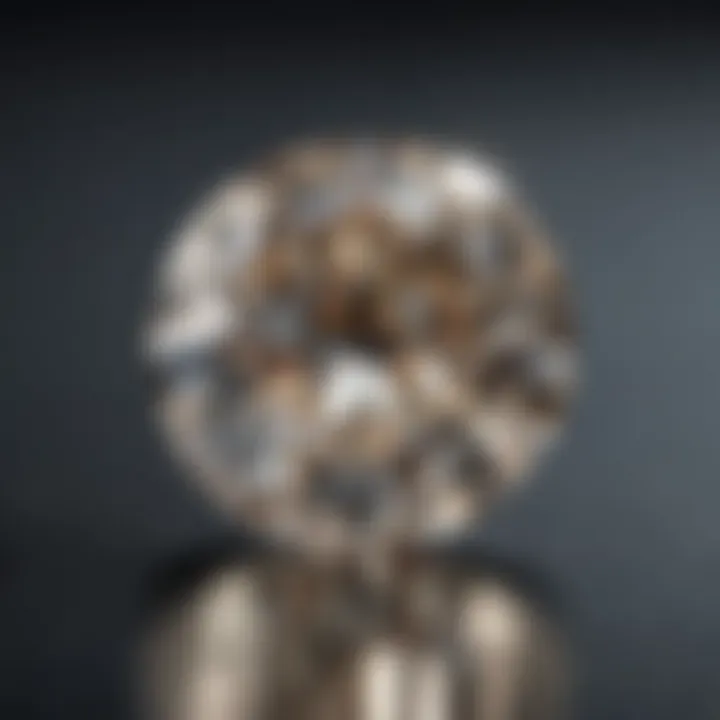
Intro
When it comes to diamonds, a 0.5 carat stone often flies under the radar. However, these gems carry a wealth of significance, making them worthy of exploration. Carat weight, cut quality, color grading, and clarity all intertwine to create a dazzling experience that goes beyond a mere crystal. Understanding what a 0.5 ct diamond represents can help buyers make sound choices.
Gemstone Overview
Definition and Characteristics
A 0.5 carat diamond weighs exactly one-tenth of a gram. This weight translates to a size that is generally perceived as suitable for various types of jewelry, from pendants to engagement rings. But it’s not just about size. Its characteristics—primarily cut, color, and clarity—shape its overall beauty and value.
- Cut: The brilliance of a diamond hinges on how well it’s cut. A quality cut can make a diamond dance with light, while a poor cut will leave it dull. A 0.5 ct diamond with an ideal cut can appear more impressive than a larger stone with mediocre craftsmanship.
- Color: Diamonds are graded based on their color. A D color diamond is the most colorless, whereas Z shows distinct yellowness. A well-graded 0.5 ct diamond can truly stand out in its clarity and hue.
- Clarity: This aspect refers to how many blemishes or inclusions are present. A diamond with fewer imperfections is generally more valuable. However, in a 0.5 ct diamond, small flaws often remain invisible to the naked eye.
Classification of Gemstones
Diamonds belong to the broader category of gemstones. They are classified based on several criteria, including hardness, origin, and composition. Here’s a closer look:
- Natural vs. Synthetic: Natural diamonds occur in nature, while synthetic ones are created in laboratories. Buyers should be cautious and ensure they know exactly what they are purchasing.
- Type: Diamonds can be divided into types based on their crystal structure and the presence of nitrogen or boron, which affects their color. For instance, Type IIa diamonds are known for their rarity and purity.
The versatility of a 0.5 ct diamond allows for diverse applications in jewelry design, making them popular among both consumers and jewelers.
Historical Significance
Ancient Uses and Cultural Importance
Historically, diamonds have been revered for their strength and beauty. In ancient India, diamonds were considered sacred and were often worshiped. Their hardness also made them symbols of power; kings and emperors adorned themselves with diamonds not just for show but to convey their might.
Myths and Legends Surrounding Gemstones
Various cultures have their own myths surrounding diamonds. Some believe wearing a diamond will bring good fortune and protection. For others, it represents love and commitment. A 0.5 ct diamond can symbolize the beginning of a journey, particularly in engagement rings where less is often more.
"A diamond is forever, yet it starts with a story. Each carat has its own tale to tell."
These narratives add a layer of richness to the experience of purchasing and cherishing a diamond.
The End
In summary, understanding the dimensions of a 0.5 ct diamond—from its physical properties to its cultural relevance—equips consumers with critical knowledge. As buyers embark on their gemstone journey, they will find that the 0.5 ct diamond does not simply reflect light; it encapsulates history, emotion, and artistry that every enthusiast can appreciate.
Defining Carat Weight
Carat weight serves as a cornerstone in the appraisal and valuation of diamonds. It's not merely a numeric indicator; it encapsulates a range of considerations that affect how a diamond is perceived—both in the eyes of buyers and the broader market. In this article, establishing a clear understanding of carat weight lays the groundwork for further insights into the specific characteristics of a 0.5 ct diamond. Beyond just weight, it incorporates elements like size perception and value correlation, which are crucial for potential buyers who want to make an informed decision.
Understanding Carat Measurement
Carat, derived from the carob seeds once used as a balance scale for weighing gemstones, specifically refers to the weight of the diamond. One carat equals 200 milligrams, which can be a common source of confusion. It's essential to acknowledge that while carat is a weight measure, it doesn't directly translate to size because two diamonds of equal carat weight can look quite different based on their cut, shape, and proportions. Here's a look at how carat is measured and expressed:
- 1 Carat = 200 mg
- 1/2 Carat = 100 mg
Understanding how carat weight translates into size perception is fundamental. A diamond that is well-cut will often display a larger face-up size compared to a poorly cut stone of the same carat weight. This discrepancy can significantly influence a buyer's choice.
Importance of Carat Weight in Diamonds
Carat weight bears considerable importance in the diamond industry for several reasons. Firstly, it often plays a crucial role in determining the price of a diamond. Typically, the larger the diamond, the greater its market value, though this isn't the whole story. Factors such as clarity, color, and cut quality also influence overall worth. Here are some key points regarding the significance of carat weight:
- Market Trends: Larger diamonds tend to be rarer and thus often command higher prices. A 0.5 ct diamond may be more affordable than a 1 ct, providing great value for buyers who want a significant stone without breaking the bank.
- Symbolic Value: In many cultures, larger carat weights symbolize affluence and status. However, personal preferences vary; some individuals may prefer the proportionality and aesthetics of a 0.5 ct diamond, particularly in settings like engagement rings where daintiness can complement the design.
- Investment Considerations: Collectors and investors often view carat weight as a baseline for valuing diamonds. However, just because a diamond has a higher carat weight does not automatically make it more valuable without assessing its clarity, cut, and color.
In summary, carat weight is not just a number—it's a crucial component that affects metrics like pricing, size perception, and even emotional resonance with the wearer. Understanding its importance allows potential buyers not only to appreciate their selection better but also to navigate the various options available in the market.
0. Carat Diamond: An Overview
When it comes to evaluating a diamond's significance, the weight measured in carats is often the first thing people think about. However, a 0.5 carat diamond holds a special place in the world of gemstones, balancing elegance and affordability. This section will illuminate why a 0.5 ct diamond is an appealing choice for many, emphasizing its attributes and addressing key considerations that potential buyers should keep in mind.
A 0.5 carat diamond is not just a smaller version of a larger stone. It represents an ideal compromise between size, cost, and the factors that contribute to a diamond's overall value. Unlike their heftier counterparts, these diamonds can easily fit into a variety of jewelry settings without overwhelming the design. The size also allows for a balance between magnificence and subtlety, making them perfect for both everyday wear and special occasions.
Physical Size of a 0. ct Diamond
To visualize what a 0.5 carat diamond looks like, think of its physical dimensions in comparison to its weight. A diamond that weighs half a carat usually measures about 5.2 millimeters across—this can differ slightly depending on the cut. The round brilliant cut, for example, optimizes sparkle without needing to be overly large, contributing to its popularity.
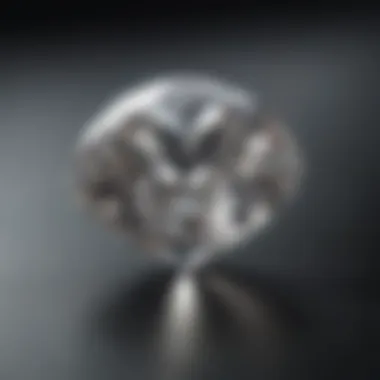
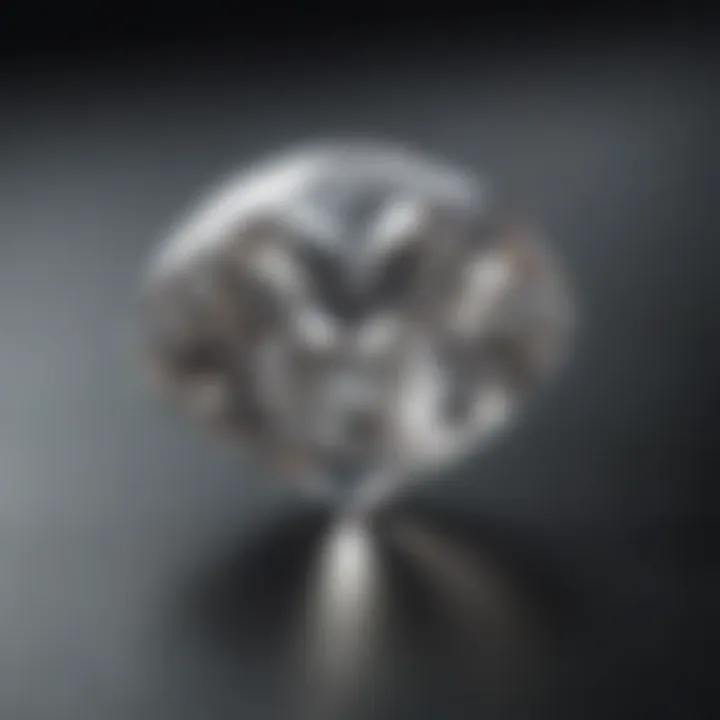
The size alone contributes to a diamond's versatility, allowing it to shine beautifully in different settings. One common approach is to use multiple smaller diamonds surrounding a central 0.5 ct piece, resulting in a dazzling display that appears more voluminous and eye-catching than a larger solitaire could achieve. This stacking style is also known for being a smart strategy for budget-conscious buyers.
When considering the physical attributes, it’s crucial to acknowledge that the perceived size may be influenced by the cut and the setting. In the right halo or three-stone arrangement, a 0.5 carat diamond can seem larger to the naked eye.
Comparative Analysis with Other Carat Sizes
A comparative look reveals much about the charm of a 0.5 carat diamond when positioned alongside other typical carat sizes.
- Smaller Diamonds: A 0.25 ct diamond appears noticeably petite next to a 0.5 ct stone. While it can be just right for minimalistic designs, it may lack the visual impact that many seek in pieces for significant occasions like engagements.
- Larger Diamonds: Conversely, a 1 ct diamond shines with impressive grandeur, but it often comes with a heftier price tag. A 0.5 ct diamond provides the same brilliancy and fire, yet at a more accessible price point, allowing for more flexible spending on other elements, like the setting or additional stones.
Consider the emotional aspect as well. Many shop for engagement rings hoping for a declaration of love that matches their commitment. A 0.5 carat diamond can symbolize this sentiment without putting undue financial strain on the buyer.
"Sometimes, it’s not just about the size of the diamond, but how it fits into the dynamic of the relationship and personal preferences.”
Evaluating Diamond Cut Quality
In the realm of diamonds, the cut holds a paramount position in how a diamond is perceived. It's not just about the shape but rather about how the facets interact with light. The quality of the cut can significantly affect a stone’s overall appearance, brilliance, and even its value. A well-cut diamond reflects light beautifully, creating that desirable sparkle, while a poorly cut one can appear dull or lifeless, regardless of its other characteristics.
The Role of Cut in Diamond Appearance
When considering a 0.5 ct diamond, the cut's influence is profound. Imagine a stone that captures light and sends it dancing around, creating a scintillation effect. This is what a high-quality cut achieves.
A diamond's cut isn’t simply about aesthetics; it affects the diamond's brightness, fire, and overall visual impact. Light enters through the crown, bounces off the pavillion, and exits through the facets. If the cut is off, light might escape before it reaches the eye, leading to diminished brilliance. Therefore, investing in a well-cut diamond is essential for showcasing its true beauty. In the world of gemstones, this is akin to polishing an old coin—without a proper finish, good details are lost, and shine is lacking.
Types of Diamond Cuts Suitable for 0. ct Diamonds
Various cuts can enhance the appeal of a 0.5 ct diamond. Each has unique traits and charms that cater to differing preferences. Here is a dive into three popular types of diamond cuts:
Brilliant Cut
The Brilliant Cut, one of the most prevalent styles, is designed to maximize light return. This means it is cut in such a manner that enhances sparkle like few others can. The round shape with its numerous facets allows for a spectacular play of light. The unique feature of the Brilliant Cut lies in its ability to reflect more light than any other cut, which makes it a standard choice for many buyers. Its popularity is supported by the belief that more facets equate to more brilliance. The trade-off? A Brilliant Cut can sometimes mask inclusions more effectively compared to others, which can be a double-edged sword for those seeking a flawless appearance.
Princess Cut
Turning to the Princess Cut, its sharp corners and square shape provide a modern twist on classic brilliance. This cut is renowned for its contemporary aesthetic while also delivering impressive sparkle due to its unique facet arrangement. It appeals particularly to those looking for something that represents stylishness and sophistication. The selling point here is that, like the Brilliant Cut, the Princess can conceal inclusions but is also known for having a higher yield of the rough diamond, making it more cost-effective for buyers. However, be cautious—princess cuts can be more prone to chipping because of those pointed corners, requiring careful handling.
Emerald Cut
Switching gears, let’s explore the Emerald Cut, which stands in stark contrast to the previous two. Instead of focusing on brilliance, this cut emphasizes transparency and clarity, creating a ‘hall of mirrors’ effect. Its long, linear facets showcase the diamond’s color more than others, often revealing the stone’s internal dynamics. The Emerald Cut is ideal for diamonds that are free from visible inclusions, thus it’s prized among gem enthusiasts who seek clarity rather than bling. However, as lovely as it is, it may not be a favorite for those who want something flashy; the understated elegance can sometimes be overlooked in favor of cuts that produce more sparkle.
"The cut of a diamond is crucial; it transforms a mere stone into a masterpiece that captivates."
In summary, choosing the right cut for a 0.5 ct diamond is about aligning personal taste with the stone's characteristics. Each cut offers advantages and drawbacks, guiding buyers to make informed decisions. Whether you are captivated by the brilliance of a traditional cut or the charm of a modern style, understanding the nuances helps ensure that your investment shines bright.
Color Grading in Diamonds
Color grading is a vital aspect in the realm of diamonds. It influences not only aesthetics but also pricing and desirability, especially for a 0.5 ct diamond. The subtle hues detected in a diamond can mean the difference between an average piece and a stunning gem. For buyers and enthusiasts, comprehending this grading system is essential for making informed decisions.
Understanding the Color Scale
Diamonds are ranked on a color scale that generally ranges from D to Z.
- D: Absolutely colorless. This is the most prized quality in a diamond, with a brilliance that few others can match.
- E - F: Colorless, but with slight color detectable under magnification. Luxury-grade options.
- G - J: Near-colorless diamonds, where color is only perceptable to a trained eye. These often represent great value.
- K - M: These diamonds show noticeable color. Typically, they are thought to be less fugged than their colorless counterparts.
- N - Z: These diamonds have a varying degree of color that’s generally not preferred in fine jewelry.
"The color of a diamond, while subtle, can radiate a magic that colorless stones might lack."
Buyers should take note of the differences, especially for a 0.5 ct diamond, as even a faint tint can alter its overall look and feel. To ensure clarity, it often helps to view diamonds side by side under similar lighting conditions.
Impact of Color on Value
When evaluating a diamond's worth, color plays a substantial role. Generally, the less color present, the higher the value. This correlation is crucial for understanding how pricing is structured in the market.
- Higher Color Grades (D-F): Often fetch a premium. These diamonds can be resold at a better price, as they attract consumers seeking perfection.
- Mid-Range Color Grades (G-J): These offer more bang for the buck. Many buyers eager to save without compromising on beauty often opt for these grades.
- Lower Grades (K-Z): While still can appeal to particular buyers, these diamonds tend to languish in the market and yield lower resale values.
It is also important to consider that color grading is not unique to diamonds alone; it can also affect the perceived quality of various jewelry settings. Choosing a 0.5 ct diamond in the right color grade can harmonize beautifully with its setting and other gemstones, creating an overall appeal.
By understanding color grading, potential buyers are better equipped to assess the true value of a 0.5 ct diamond and make wise purchases that align with their preferences and budgets.
Clarity: Assessing Internal Flaws
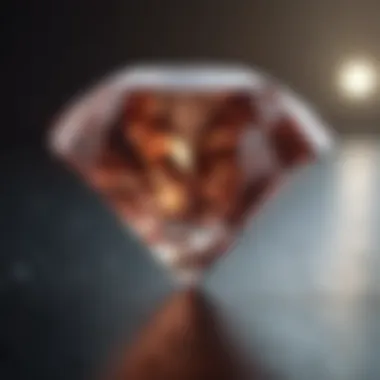
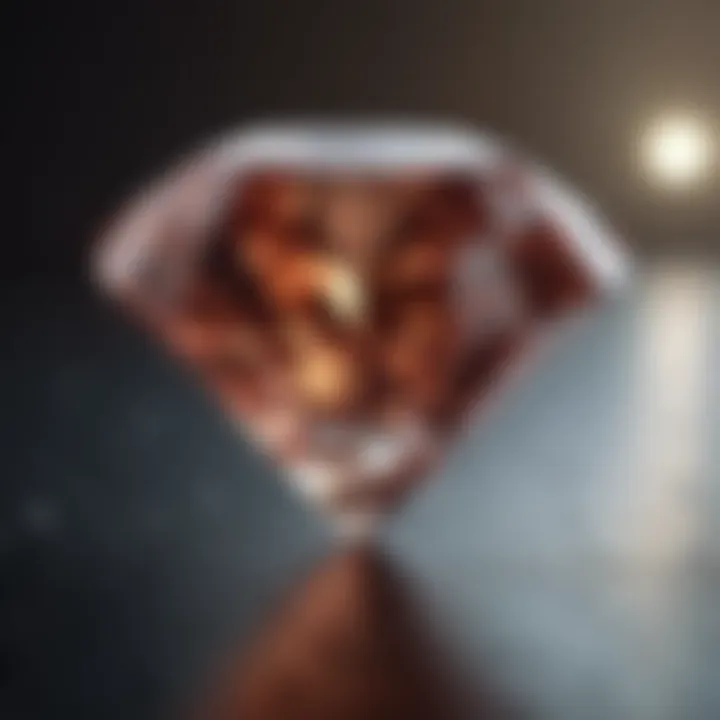
When it comes to diamonds, clarity is a key player in the game of quality and value. This pertains to the presence of internal flaws or inclusions within the stone. The fewer imperfections a diamond has, the clearer and more brilliant it will appear to the naked eye. This clarity not only impacts aesthetic appeal but also plays a significant role in determining the overall value of the diamond. For a 0.5 ct diamond, understanding clarity is essential, as it can make a notable difference in how the gem sparkles in the light and how much you might pay for it.
Clarity Grading Scale
The clarity of diamonds is judged using a specific grading scale. The most common scale runs from Flawless (FL) to Included (I). Here’s a brief rundown of the categories:
- Flawless (FL): No inclusions or blemishes visible under a 10x microscope.
- Internally Flawless (IF): No inclusions visible under a microscope, though there may be negligible surface blemishes.
- Very, Very Slightly Included (VVS1 and VVS2): Minute inclusions that are very difficult to see even for experienced gemologists.
- Very Slightly Included (VS1 and VS2): Minor inclusions that can be seen with some effort under a microscope.
- Slightly Included (SI1 and SI2): Inclusions that are noticeable under a 10x magnification and may be visible to the naked eye.
- Included (I1, I2, I3): Inclusions that are easily visible under 10x magnification and may affect the diamond’s brilliance and transparency.
This grading system offers insights into what clarity actually means in practical terms. For instance, a 0.5 ct diamond rated as VVS1 might cost more than an SI1 diamond due to its superior clarity and resulting visual appeal.
The Effect of Clarity on Diamond's Brilliance
Now, let’s talk about brilliance. The clarity of a 0.5 ct diamond has significant influence on how much light enters and exits the stone. Here are some notable points:
- Light Reflection: A diamond with fewer inclusions allows light to move freely within the stone. This enhances its ability to reflect light, leading to a dazzling display of sparkle. Conversely, inclusions can obstruct that light, dulling the overall shine.
- Visual Perception: When you’re looking for a diamond, clarity plays a role in what you perceive as beauty. A clearer diamond will often appear more mesmerizing, making it more desirable to many buyers who want that ‘wow’ factor.
- Long-term Value: Clarity affects more than just the initial impression; it can also influence the diamond’s long-term value. Diamonds with higher clarity ratings typically retain their worth better than those with many visible inclusions.
In many cases, buyers might prioritize color and cut, but clarity remains a crucial aspect in determining the overall desirability and value of a diamond.
As a summary, clarity assessment is more than just a technicality; it’s a fundamental characteristic that helps define a diamond's beauty and value. When investing in a 0.5 ct diamond, keeping an eye on the clarity scale can guide you toward making a wise purchase.
Market Trends for 0. ct Diamonds
When it comes to acquiring a diamond, understanding market trends is essential, particularly for a 0.5 carat diamond. This segment provides insight into historical fluctuations and current buyer preferences. Knowing these aspects can guide potential purchasers in making wise, informed choices in a competitive marketplace.
Historical Price Trends
Over the years, the pricing of diamonds has undergone several shifts influenced by various economic, cultural, and market dynamics. Understanding these historical trends, especially for a 0.5 ct diamond, reveals not only how prices have changed over time but also helps in predicting future values. Traditionally, the price of diamonds was closely tied to supply and demand. A significant event, such as economic recessions or booms, can lead to drastic changes in consumer spending on luxury items like diamonds. In the last ten years, the price of 0.5 carat diamonds has often seen increases due to rising raw material costs and an increase in demand from younger buyers. Additionally, marketing efforts from major diamond retailers have reinforced the perception that even smaller diamonds are valuable centerpieces in jewelry.
However, it's also crucial to note fluctuations caused by market saturation. The introduction of lab-grown diamonds, which offer a more affordable alternative, has begun to change the pricing landscape. Buyers looking for eco-friendly options may lean towards these alternatives, which also contributes to changing demand for mined stones like a 0.5 ct diamond. As a prospective purchaser, having a grasp on these fluctuations not only aids in valuation but also enriches strategic buying approaches, ensuring better decisions.
Current Buying Trends and Consumer Preferences
The current demand versus supply balance paints a vivid picture of why a 0.5 ct diamond remains a popular choice among consumers. It’s the kind of item that strikes a fine balance; it's not too minuscule to go unnoticed, yet not overly ostentatious. The practicality of this size plays well in various settings—be it engagement rings, everyday wear, or even as a thoughtful gift.
Consumer preferences have shifted towards more conscious purchasing, and this has had a noteworthy effect on how people choose diamonds today. Buyers increasingly prioritize ethical sourcing, with many opting for conflict-free diamonds. This shift is significant because it reflects growing awareness around sourcing practices among consumers, particularly younger demographics who are more vocal about their values when buying.
Moreover, the digital age has transformed how diamonds are marketed and sold. Online retailers have thrived by showcasing a variety of options at competitive prices, providing transparency that many traditional jewelers may lack. The convenience of online shopping allows potential buyers to explore numerous designs and settings, tailoring pieces to individual preferences and budgets.
Key aspects of current trends include:
- Preference for Ethical Sourcing: Many buyers are actively seeking conflict-free diamonds, affecting what’s available in the marketplace.
- Online Shopping Growth: The rise of e-commerce platforms offers more choices and competitive pricing for consumers.
- Customization: There is an increasing demand for personalized jewelry, with many opting for unique designs that reflect personal style.
The Ideal Use Cases for a 0. ct Diamond
Diamonds, especially those weighing 0.5 carats, hold a unique space in the market. Their moderate size combined with noticeable brilliance makes them suitable for various applications. Understanding these use cases can significantly aid potential buyers in making informed choices, emphasizing their value beyond mere aesthetics. With factors such as emotional significance and market considerations tied closely to their selection, the 0.5 ct diamond shines brightly in numerous contexts.
Engagement Rings and Jewelry Settings
When it comes to engagement rings, a 0.5 ct diamond successfully strikes a balance between size and affordability. Engagement is often a mixture of deep personal sentiment and practical financial considerations. Many couples find a 0.5 ct diamond optimal, offering a sparkling option that doesn't break the bank. In recent trends, designs that feature a sole diamond or elegant clusters are particularly popular. A well-placed four or six-prong setting can enhance the visible size and brilliance of the stone, ensuring maximum impact.
But let's not gloss over practical aspects. The weight of a 0.5 ct diamond makes it less prone to snagging on clothing compared to larger stones. It’s more comfortable for daily wear while maintaining a graceful appearance in a variety of settings, such as vintage designs or classic solitaires. Many also choose to adorn other pieces, like stud earrings or pendants, with 0.5 ct diamonds. Its versatile size transitions flawlessly between casual and formal wear, making it a fantastic addition to any jewelry collection.
Collectible Quality and Investment Potential
Stepping into the realm of collectibility, a 0.5 ct diamond presents a desirable choice for both collectors and investors. While bigger diamonds can often garner more attention, the market for smaller, high-quality stones is more stable and accessible. Not to mention, a 0.5 ct diamond can come with an impressive cut and clarity at a reasonable price point, making it more feasible for those starting their collection.
Investors might also appreciate the lower risk associated with smaller diamonds, as price fluctuations can be less pronounced. Plus, the ability to acquire greater quality or better characteristics within the same budget is quite appealing. Many collectors focus on the exceptional cut, color, and clarity when selecting pieces that are likely to appreciate in value over time.
As the diamond market evolves, it’s essential to stay informed. Collectors should pay attention to the certifications associated with their purchases, such as those from the Gemological Institute of America (GIA) or the International Gemological Institute (IGI), as verified diamonds tend to retain value. Additionally, special collections and limited editions featuring renowned designs could pique an investor's interest.
"The beauty of a 0.5 ct diamond lies not just in its clarity and brilliance but in the emotional stories it carries."
In essence, the 0.5 ct diamond serves dual roles, showcasing romanticism in personal adornment and providing a sound investment strategy. Thus, whether destined for an engagement ring or cherished as a collectible, its value remains undeniable.
Ethical Considerations in Diamond Purchasing
When it comes to purchasing diamonds, especially a 0.5 ct diamond, ethical considerations have stepped into the spotlight more than ever before. Jewelry lovers and buyers are becoming increasingly conscious of where their gems are sourced from. This focus isn't just a trend; it reflects a growing awareness about the impact of diamond mining on communities and the environment.
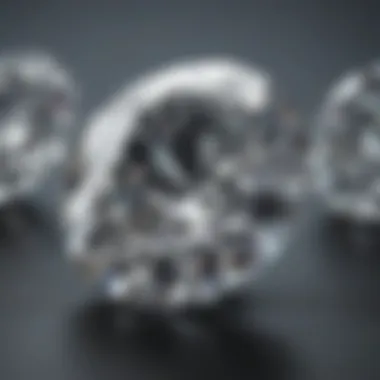

Understanding Conflict-Free Diamonds
Conflict-free diamonds are those that are mined and sold without funding war or human rights abuses. This notion gained traction in the early 2000s when reports highlighted that many diamond mines were financing horrific civil wars in places like Sierra Leone and Angola. Knowing that your diamond is conflict-free adds a layer of peace of mind to your purchase. It ensures that you’re not inadvertently supporting unethical practices that may result in suffering for those involved in the mining process.
When shopping for a 0.5 ct diamond, it’s vital to inquire about its origin. Jewelers should provide a guarantee that their diamonds comply with the Kimberley Process, which was established to certify the origin of diamonds. This process aims to prevent conflict diamonds from entering the mainstream market. So, always ask: "Is this gem conflict-free?" This simple question can make a significant difference in your purchasing choice.
Certification and Grading Reports
Certification and grading reports are key components in understanding the value and quality of a 0.5 ct diamond. These documents are like the diamond's resume, providing detailed information on its cut, color, clarity, and carat weight. Institutions like the Gemological Institute of America (GIA) and the International Gemological Institute (IGI) are known for their rigorous grading standards. These certifications ensure that the diamond you are eyeing is accurately represented.
When buying, look for a diamond that comes with a reliable grading report. Not only does this report affirm the diamond's ethics and quality, but it also serves as an assurance for your investment. A certified diamond is typically easier to buy and sell as they hold a more consistent value in the marketplace.
In summary, making ethical choices when purchasing diamonds reflects a sense of responsibility and contributes to changing the dynamics within the industry. By being aware of conflict-free statuses and ensuring proper certification, buyers can feel more connected to the value of their jewelry while also advocating for ethical practices in diamond sourcing.
"Purchasing ethically sourced diamonds is a step towards supporting communities and preserving the beauty of our planet."
Final Thought
Embracing these ethical considerations not only leads to informed purchasing decisions but also to a broader positive impact on the diamond industry. Thoughtful consumers can champion the change, turning each purchase into a statement of values.
Maintenance and Care for Diamonds
Taking care of a diamond is not just about keeping it shiny. It's about ensuring that your investment stays intact for generations to come. Proper maintenance and care are crucial, particularly for a 0.5 ct diamond, which often carries sentimental value alongside its monetary worth. A diamond, under its charming facade, is a hard substance, yet it can be prone to scratches, dirt, and other forms of wear if not tended to carefully. This section aims to shed light on how regular maintenance can preserve the beauty and integrity of your diamond, making it more than just a momentary accessory.
Cleaning Methods for Diamonds
Keeping your diamond clean is essential. Dust and skin oils can build up over time, hiding its brilliance. Fortunately, there are simple methods to clean your 0.5 ct diamond without professionals. Many folks tend to forget that a little TLC goes a long way.
- Use Mild Soap and Water: Mix a few drops of dish soap with warm water. Soak the diamond for about 20-30 minutes, then gently brush it with a soft toothbrush. Rinse it thoroughly with clean water and pat dry with a lint-free cloth.
- Ultrasonic Cleaners: These devices are becoming increasingly popular. They use sound waves to create tiny bubbles that gently remove dirt. While they’re effective, one must be cautious—certain diamonds might have treatments that could be negatively affected.
- Professional Cleaning: No matter how diligent you are, a professional deep clean every year or so is a good idea. Jewelers have specialized equipment that can reach crevices where dirt likes to hide.
Storage Recommendations to Preserve Quality
To keep your 0.5 ct diamond looking its best, the way you store it is just as significant as how you clean it. Storing your diamond improperly can lead to damage or loss of luster. Here are some tips:
Avoiding Scratches
One important aspect of avoiding scratches is understanding how different materials interact. Diamonds are tough but can scratch other diamonds or softer stones. Store your diamond separately, perhaps in a pouch or a dedicated compartment in a jewelry box. This practice keeps it from coming into contact with potentially harmful surfaces.
The key characteristic here is that by keeping your diamond isolated, you're taking preventive measures to maintain its shine and clarity—an admirable choice for enthusiasts who truly value their collection.
While this may seem trivial, consider that prevention is always better than a cure. If those little scratches accumulate over time, your diamond’s allure could fade. The unique feature of avoiding scratches goes further; it also prolongs the time between deep cleanings, saving you both effort and expense in the long run.
Environmental Considerations
Next, let's discuss environmental considerations. The climate in which you live can affect both the diamond's physical state and your cleaning regimen. For instance, high humidity can lead to moisture buildup, while super-dry environments might not only dry out any rubber bands or storage materials but can also impact the diamond indirectly.
The key to understanding this is the moisture barrier. Using desiccants or humidity-controlling bags can help store your diamond safely. This practice can keep your precious jewel in top shape while preventing unwanted damages—having a beneficial impact on your investment. One unique factor here is how temperature fluctuations can cause expansion and contraction in metals, leading to loose settings, and a diamond might find itself precariously positioned.
Being proactive helps safeguard against ensuring the longevity of your prized diamond. Ultimately, both avoiding scratches and considering the environment contribute to maintaining the integrity and appearance of your 0.5 ct diamond, making it a lasting symbol of beauty.
Future Outlook for the Diamond Market
The diamond market is a constantly evolving landscape influenced by a myriad of factors. Understanding its future is of paramount importance not just for enthusiasts, collectors, and jewelry designers but also for investors venturing into this sparkling realm.
The ongoing shifts in consumer preferences, the emergence of new technologies, and ethical considerations are at the crux of anticipated changes in the market. By decoding these elements, potential buyers can make more tailored decisions, ensuring they invest in diamonds that not only meet their aesthetic desires but also align with their values.
As we delve deeper into this section, we will break down two fundamental components shaping the diamond industry: anticipated trends in diamond sales and the innovative technologies that are revolutionizing production methods.
Anticipated Trends in Diamond Sales
The diamond sales landscape is responding dynamically to the changing attentions of consumers and market-global events. Some of the key anticipated trends include:
- Growing Demand for Sustainable Diamonds: More buyers are opting for conflict-free and lab-created diamonds, reflecting a shift towards ethical consumption. These diamonds appeal to a conscientious market segment that values sustainability.
- Customization and Personalization: Shoppers increasingly seek unique pieces that reflect their personalities. Unique cuts, custom engravings, and bespoke jewelry are expected to increasingly dominate the market.
- Online Sales Growth: The rise of e-commerce has altered how diamonds are bought and sold. Future sales are likely to see a surge through online platforms, where buyers can explore a vast selection of diamonds without geographic limitations.
- Influence of Social Media: Platforms like Instagram and TikTok are becoming essential in shaping consumer behavior. Visual platforms promote diamond jewelry to broader audiences, affecting trends and sales.
"In a world where choices abound, consumers show a growing desire for diamonds that tell their unique stories."
These shifts have implications for pricing, demand, and the types of diamonds that jewelers stock, thus showcasing the importance of industry adaptability.
Emerging Technologies in Diamond Production
As we look to the future, technologies in diamond production promise to transform the industry in numerous ways:
- Lab-Created Diamonds: The production techniques for lab-created diamonds, using processes like chemical vapor deposition, are becoming increasingly refined. They not only offer a more affordable option but also significantly reduce the environmental footprint associated with mining. They tend to maintain the same quality as mined diamonds, making them a favorable choice for many.
- Advanced Processing Techniques: New methods in sorting and grading diamonds are appearing, utilizing artificial intelligence to enhance accuracy and efficiency in determining quality. This allows retailers to provide more precise information to consumers, fostering trust and informed purchasing decisions.
- Blockchain Technology: This technology offers a significant advancement in tracking the provenance of diamonds. By ensuring transparency, blockchain helps combat issues like conflict diamonds, assuring buyers that their purchases are ethically sourced.
The continuing innovation in diamond production and sales speaks to a future that is not just about brilliance and beauty but about responsibility and conscientious choices. Understanding these evolving dynamics will better equip buyers and stakeholders to navigate the diamond market effectively.







